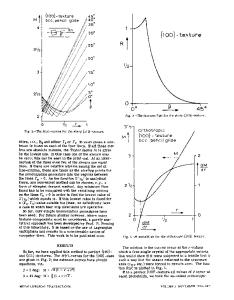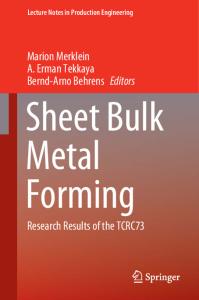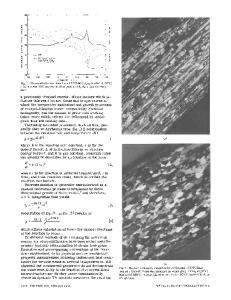Plastic behavior of 70/30 brass sheet
- PDF / 1,091,544 Bytes
- 10 Pages / 594 x 774 pts Page_size
- 11 Downloads / 367 Views
I.
INTRODUCTION
A
knowledge of the plastic behavior of sheet metals is required for accurate modeling of deformation processing such as drawing, bending, or stretching. Although the type of processing determines the final strain states, a majority of the split failures encountered in automotive stampings occurs near plane-strain tension. 1It is particularly important, therefore, to develop detailed understanding of the mechanical behavior of sheet alloys in this strain state. The most general theory of plasticity is not directly suitable for analysis of applied forming problems because of the lack of predictive capability. It is only upon making certain key assumptions that the theory can be used predictively. In fact, the particular set of assumptions and definitions employed serve to differentiate among the proposed models. In what follows, the important assumptions and consequences of classical plasticity theory will be outlined by examining a particular anisotropic theory of plastic flow. Some proposed modification, and counter-evidence to these assumptions and consequences will then be discussed and, finally, experimental evidence of the plastic behavior of brass will be reviewed.
A. Classical Plasticity--Hill's Theories Several early anisotropic theories2-5 of plastic yielding were developed independently. The most commonly applied theory, proposed by Hill,4'5 is based on a quadratic yield function6 exhibiting orthotropic symmetry. When two of the symmetry axes are equivalent, the theory exhibits only "normal" anisotropy (i.e., normal to the plane of isotropy, for example, in the plane of a sheet) and requires fitting of only one anisotropy parameter, 7. A newer version of this theory7-1~employs two anisotropy parameters, 7 and m, to adjust the yield surface shape. Analogous to the yield surface, the incremental plastic strain ratios are prescribed by a plastic potential, g:
dg( o o) de~ = d A - dcrii
[1]
Several arguments equating the plastic potential and yield surface have been proposed, t~ and this condition is R.H. WAGONER is Staff Research Scientist, Physics Department, General Motors Research Laboratories, Warren, MI 48090-9055. Manuscript submitted November 17, 1981. METALLURGICAL TRANSACTIONS A
known as "normality". Normality demands that the type of anisotropy exhibited by the incremental strain ratios agree with the yield surface anisotropy, and allows development of associated flow rules. The normality condition allows measurement of the yield surface anisotropy via the strain ratios measured in tensile tests. The plastic anisotropy parameter, r, is defined as the width-to-thickness strain ratio and r is the average over tested sheet directions. In the new theory, m is usually measured by comparing yield stresses in two or more strain states. There is, therefore, an important conceptual difference between 7 and m. If normality is not satisfied, 7 is a measure only of the plastic potential's normal anisotropy whereas m is a direct measure of the yield surface anisotropy.
B. Modifications t
Data Loading...











